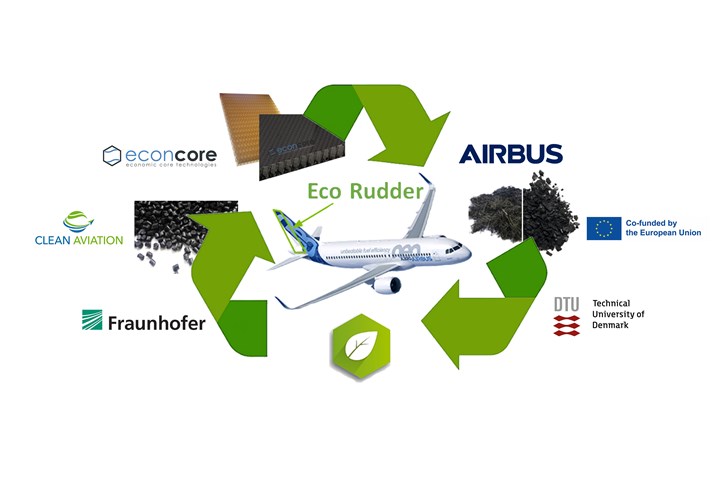EcoRudder project to develop thermoplastic composite aircraft rudder
Airbus, EconCore, Fraunhofer and the Technical University of Denmark will produce a potentially recyclable rudder from thermoplastic honeycomb sandwich composites.

Sandwich core supplier EconCore (Leuven, Belgium) is collaborating with Airbus (Toulouse, France), the Technical University of Denmark (DTU, Kongens Lingby) and Fraunhofer on a potentially recyclable rudder for an Airbus A320 aircraft, made from thermoplastic honeycomb sandwich composites.
This endeavor forms the work package EcoRudder in the project FASTER H2, which is funded by the European Union’s Clean Aviation Research Program under Horizon Europe and led by Airbus. EcoRudder focuses on the development of a new generation rudder structure for a single-aisle commercial aircraft. It is envisaged that the rudder structure will be redesigned and replaced with thermoplastic materials that have the potential to be recycled after the aircraft has been decommissioned.
Within the scope of the project, thermoplastic honeycomb sandwich structures will be produced and evaluated against the requirements for the rudder, and a recycling concept for the panels will be demonstrated. Extensive testing and analysis will be done to ensure that the materials meet all requirements for a certification in a structural aircraft component, as well as a detailed life-cycle analysis (LCA) performed to confirm the reduced CO2 footprint of the new thermoplastic honeycomb sandwich rudder.
According to EconCore, composite sandwich construction has proven to be a very efficient structural concept in structural aircraft parts. In line with today’s sustainability requirements, “green” or more sustainable/recyclable composites are expected to replace conventional thermoset materials such as phenolic resin honeycombs and epoxy laminates. This improvement in sustainability has to be achieved without compromising on mechanical requirements such as damage tolerance under extreme environments and unintended loading scenarios. Sufficient robustness and structural integrity against service loads, as well as potentially recycling of the thermoplastic constituent materials, must also be ensured.
Related Content
-
Composites end markets: Electronics (2024)
Increasingly, prototype and production-ready smart devices featuring thermoplastic composite cases and other components provide lightweight, optimized sustainable alternatives to metal.
-
MFFD thermoplastic floor beams — OOA consolidation for next-gen TPC aerostructures
GKN Fokker and Mikrosam develop AFP for the Multifunctional Fuselage Demonstrator’s floor beams and OOA consolidation of 6-meter spars for TPC rudders, elevators and tails.
-
Manufacturing the MFFD thermoplastic composite fuselage
Demonstrator’s upper, lower shells and assembly prove materials and new processes for lighter, cheaper and more sustainable high-rate future aircraft.

.jpg;width=70;height=70;mode=crop)











